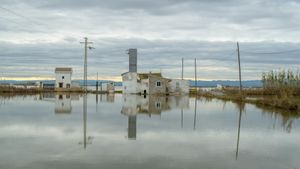National Parks across the United States are some of the nation's greatest treasures, renowned for their breathtaking landscapes and biodiversity. Unfortunately, many of these parks face serious challenges, primarily stemming from climate change and insufficient funding.
Each year, these iconic destinations draw millions of visitors eager to experience nature at its most majestic. From the roaring waterfalls of Yosemite to the sprawling canyons of the Grand Canyon, these parks are more than just beautiful scenery; they house unique ecosystems and wildlife.
Climate change poses several critical threats to the health of national parks. Rising temperatures and irregular precipitation patterns are impacting flora and fauna, altering delicate ecosystems.
For example, research shows certain species are being forced to migrate to cooler areas, threatening their survival and the overall balance of these ecosystems. The Adirondack Park, renowned for its rich biodiversity, is experiencing shifts as habitats change due to warmer temperatures.
Wildfires have become increasingly common, exacerbated by climate change and outdated forest management practices. Such fires endanger both natural landscapes and the historical structures dotting park grounds.
National Park Services (NPS) employees are working hard to combat these issues, but they often face limited budgets and resources. The NPS has reported being approximately $670 million behind on necessary maintenance and upkeep across various parks.
This maintenance backlog presents risks to park facilities, including visitor centers and park roads, which are critical for maintenance and access for visitors. Exploring potential revenue streams, park officials are considering options like increased park fees and donations as ways to address funding gaps.
Visitor numbers have soared, especially during peak seasons, putting additional strain on park resources. The influx of tourists often leads to overcrowding and increased waste, which can disrupt wildlife and threaten natural habitats.
To mitigate these challenges, many parks are implementing environmental education programs for tourists. These initiatives aim to promote conservation efforts and responsible behavior among visitors.
Locals are also stepping up to join conservation efforts. Across the country, community activists and volunteers are coming together to clean parks and raise awareness about environmental protection.
Another key concern is the impact of invasive species. These non-native plants and animals can outcompete local species, significantly disrupting ecosystems.
For example, the introduction of certain plants has changed the dynamics of the flora and fauna within parks like Shenandoah. These invasive species can be difficult to manage and require extensive training for park staff to effectively combat their spread.
Scientists are working closely with NPS to develop comprehensive approaches to tackle the invasive species issue. Such strategies include early detection and rapid response methods to prevent the establishment of harmful invaders.
Pollution also poses significant risks to national parks. Air quality can affect both the health of visitors and the wildlife inhabiting these areas.
The air pollution challenge is aggravated by proximity to urban centers as harmful emissions drift toward national parks. Maintaining air quality standards is critical for preserving ecosystems and providing visitors with clean environments.
Weather events, propelled by climate change, have wreaked havoc on park infrastructure. Intense storms, flooding, and rising sea levels have all contributed to devastating effects on park roads and buildings.
Officials often have to weigh the costs of immediate repairs against long-term solutions aimed at delivering resilience against future risks. Adapting to these potential changes is becoming part of the planning processes for many national parks.
Local communities surrounding parks can also feel the impact of climate change. Economies reliant on tourism may suffer during severe weather events, making it critical for such communities to diversify revenue sources.
Parks like Yellowstone have begun to develop partnerships with local businesses to better prepare for and respond to environmental changes. Such partnerships can play elemental roles as towns aim to boost resiliency efforts.
Efforts to preserve biodiversity are underway, with several parks launching initiatives to collect genetic materials from endangered plants and animals. By preserving this genetic diversity, officials hope to safeguard the survival of struggling species.
One exciting development is the use of beavers as ecological engineers. Their natural behaviors can restore habitats and improve water quality within the parks.
Research has shown the beneficial effects of reintroducing beavers, especially as they create ponds—critical to many other species for their survival. Parks like Grand Teton are studying these effects on ecosystems and biodiversity.
Visitor engagement is also being prioritized concerning wildlife interactions. Parks are increasingly providing educational resources to inform visitors about respecting wildlife boundaries and minimizing disturbances.
These resources include signage, guided tours, and even ranger programs aimed at sharing knowledge about local ecosystems. Educated visitors are likelier to engage responsibly with nature.
Volunteer programs are another effective way to involve visitors directly. These programs invite guests to participate actively, helping with conservation efforts like trail restoration and clean-up days.
Such hands-on experiences help to promote stewardship among participants. Volunteer days also allow individuals to discover their affinity for preserving these natural spaces.
Many national parks advocate for policies addressing climate change at the legislative level. They encourage citizens to engage with their representatives to support funding and initiatives aimed at safeguarding parks.
While managing the diverse challenges facing national parks may seem overwhelming, collective efforts can effect real change. Engaging visitors, local communities, and policymakers is key to ensuring these precious landscapes endure for future generations.
National parks are not just sites for recreation, they’re living ecosystems requiring protection and care. By advocating for sustainability and conservation as individuals and communities, everyone plays a part.
Mobilizing local communities and their resources can amplify efforts within national parks. Through collaboration, education, and advocacy, it is possible to address the pressing concerns facing these cherished landscapes.
Everyone can be involved, whether through volunteering, visiting responsibly, or advocating for environmental policies. The urgency of protecting these natural spaces is more pressing than ever, and it starts with collective action.



